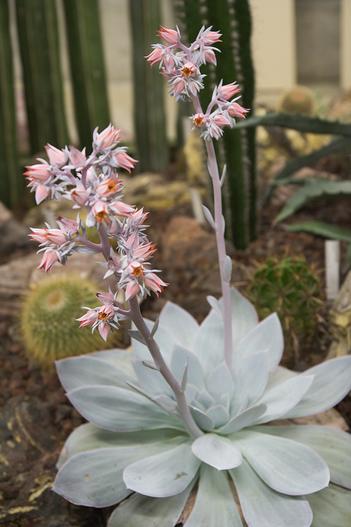White Cloud Plant
(Echeveria cante)
White Cloud Plant (Echeveria cante)
/
/

Ikiwaner
CC BY-SA 3.0
Image By:
Ikiwaner
Recorded By:
Copyright:
CC BY-SA 3.0
Copyright Notice:
Photo by: Ikiwaner | License Type: CC BY-SA 3.0 | License URL: http://creativecommons.org/licenses/by-sa/3.0/ | Uploader: Ikiwaner | Publisher: Wikipedia Commons











Estimated Native Range
Summary
Echeveria cante, commonly known as White Cloud Plant, is an evergreen succulent originating from the rocky outcrops and semi-desert regions of Central Mexico. It typically grows to a height and width of 1-2 feet (0.3-0.6 meters). This plant forms a rosette of large, powdery blue leaves that can add a striking texture and color contrast in gardens. The leaves are often edged with a delicate pink or red line, enhancing its ornamental value. During the summer, Echeveria cante produces arching inflorescences bearing clusters of pink flowers, which are quite showy and attract pollinators.
The White Cloud Plant is valued for its drought tolerance and architectural form, making it a popular choice for rock gardens, succulent collections, and as a container specimen. It is also recognized for its low maintenance requirements and has earned the Royal Horticultural Society’s Award of Garden Merit. In cultivation, it prefers part shade to full sun exposure, very low to low water needs, and well-draining soils. While it is generally disease-resistant, overwatering can lead to root rot. It is also susceptible to mealybugs and aphids. To prevent these issues, ensure proper watering practices and inspect plants regularly. Echeveria cante is not known for being invasive and can be propagated easily from leaf cuttings or offsets, making it an excellent plant for enthusiasts to share and exchange.CC BY-SA 4.0
The White Cloud Plant is valued for its drought tolerance and architectural form, making it a popular choice for rock gardens, succulent collections, and as a container specimen. It is also recognized for its low maintenance requirements and has earned the Royal Horticultural Society’s Award of Garden Merit. In cultivation, it prefers part shade to full sun exposure, very low to low water needs, and well-draining soils. While it is generally disease-resistant, overwatering can lead to root rot. It is also susceptible to mealybugs and aphids. To prevent these issues, ensure proper watering practices and inspect plants regularly. Echeveria cante is not known for being invasive and can be propagated easily from leaf cuttings or offsets, making it an excellent plant for enthusiasts to share and exchange.CC BY-SA 4.0
Plant Description
- Plant Type: Succulent
- Height: 1-1.5 feet
- Width: 1-1.3 feet
- Growth Rate: Moderate
- Flower Color: Orange, Pink
- Flowering Season: Spring, Summer
- Leaf Retention: Evergreen
Growth Requirements
- Sun: Full Sun, Part Shade
- Water: Very Low, Low
- Drainage: Fast
Common Uses
Bird Garden, Border Plant, Drought Tolerant, Fire Resistant, Groundcover, Hummingbird Garden, Low Maintenance, Potted Plant, Rock Garden, Showy Flowers, Street Planting
Natural Habitat
Originating from the rocky outcrops and semi-desert regions of Central Mexico
Other Names
Common Names: White Cloud
Scientific Names: , Echeveria cante,
GBIF Accepted Name: Echeveria cante Glass & Mend.-Garc.